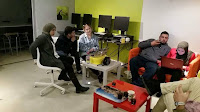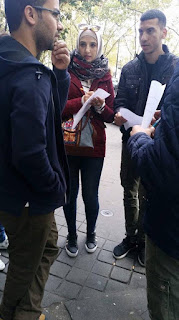CADFA Summer School Wednesday September 6th.
Walking up the hill from our meeting centre in Abu Diss
takes us around ten minutes before we come to the university campus of Al-Quds.
It’s impressive. Lots of large buildings, wide walkways, architectural features.
A wide depression in the paving lined by concentric rows of stone steps, like a
miniature amphitheatre, has a large fountain at the centre. Many of the
individual buildings and departments have been financed by wealthy diaspora
Palestinians and it all looks clean, modern and efficient.
We are met by staff and students who welcome us with cool
fruit juices and lots of smiles. Some of our group know the students from
visits and it’s clear this is going to be a very friendly exchange.
It’s hot. We’re led into the cool of an air-conditioned room
we take our places in a large circle.
We’re around 30 visitors and Al-Quds students so the first
task is to break the ice and get to know each other. We introduce ourselves
individually before we play a few games – funny slapstick games where we have
to get up and do silly actions, eliminate each other through swift reactions,
generally get to know each other and relax. .
Our first formal meeting is with the Dean of Student Affairs
who outlines the history of Al-Quds University (AQU) and its success. With over
13,000 students and several campuses the mere existence of AQU is a great
achievement, given the obstacles and continual harassment by the Israeli
authorities. The separation wall makes life very difficult – many students from
Jerusalem and the West Bank choose to live in Abu Diss rather than endure the
lengthy travel and routine humiliations of the checkpoints, but even travelling
between campuses often involves passing through the checkpoints.
We’re told that Israeli soldiers can invade the campus at
any time, with or more often without any form of provocation and always without
warning. Such incursions are regular, as often as once a week, with tear gas
grenades, rubber bullets and live rounds. We’re shown the destruction caused by
some of these raids – photos of lecture halls and admin rooms filled with
rubble and smashed equipment such as photocopiers. Students have been shot on
the campus and it seems there is no protection, so the continual threat of
violence hangs over these students, including our new friends.
There are several museums on campus and on this first day we
visit two of them.
First, the Mathematics Museum. This is a large hangar-like
building next to the separation wall, which adjoins the university. It’s a
large space filled with interactive demonstration pieces which all illustrate
various mathematical principles. There’s a chessboard with Perspex columns
arranged on the squares which are filled with rice grains to illustrate
exponential growth. There are pendulums, wooden rings on metal spigots, charts
of numbers, all kinds of simple machines to explore. Our guide takes us though
half a dozen of these, explaining the mathematical principles. It’s fun. The
museum is the first of its kind in Palestine and over eight years has seen over 250,000 visitors,
mainly young children but also their families.
The second museum, a five minute walk from the first, is the
Science Museum. Here again we find a succession of appliances and demonstration
pieces and the museum director takes us on a tour. We see various machines
grouped under themes such as electricity, audio, kinetics, visual phenomena.
Many of the demonstration pieces are sophisticated and our group happily
experiments with, for example, an exhibit which demonstrates the interaction of
different wave forms. The bicycling skeleton is a little macabre, the chair of
nails surprisingly comfy.
For lunch we’re taken to a campus / café ‘Sudfeh’, which is
vegan. It’s the first vegan restaurant in Palestine and part of a project to
foster animal rights. The exchange team has negotiated a special deal for us
and those who stayed (several meat-cravers went elsewhere) had a treat: An
outside table covered with dishes of various kinds with dips (humus, ful, baba
ganoush), salad, halloumi, tomato… with plenty of bread, mint tea and cold
drinks included. We couldn’t eat it all! The meat-eaters who came to eat their
sandwiches nearby seemed surprised at our spread.
After lunch we all returned to Dar Assadaqa (House of
Friendship), which is here the Abu Diss side of the exchange is based.
We have a rota. Each team has to take turns cooking a
communal meal, and tonight is maklouba! Luckily one of the Palestinian
volunteers is helping out as we need expertise for this dish.
Well, we can say that the evening meal is a great success. Everyone has lots of delicious food, and we
are joined by family members of the Abu Diss staff. Those tiny Palestinian
girls can dance really well (talking about 5-year olds!
Having made various enquiries we have a general idea about
how prepare maklouba, unless we’ve been misled by Ollie our man on the inside
and whose identity must be kept secret:
You’ll need enough chicken pieces for everyone (1-2 each),
rice, vegetables, cooking oil (not olive), salt, pepper, spices.
Clean and chop vegetables for the salad (cucumber, tomatos)
nice and small.
Fry the vegetables for the dish (potatoes, cauliflower and
carrots) for the main dish, remove from the pan, set aside.
Season the chicken pieces, mix with chopped onion and garlic
and fry in the oil. When the pieces are well-browned, add water to cover the
pieces well.
Add the vegetables. Add rice – as an estimate I’d say half
as much rice by volume as the amount of water, but our informant was a little
hazy on this point.
When the rice is cooked the meal is ready.
To be on the safe side I’d recommend investing in a book on
middle eastern cookery – maklouba is a regional standard and I’m sure there
will be less risk of failure than by following the above!
There was a fair amount to wash up but with plenty of
volunteers this was soon done and our first full day was over. Tomorrow – Jerusalem!




















